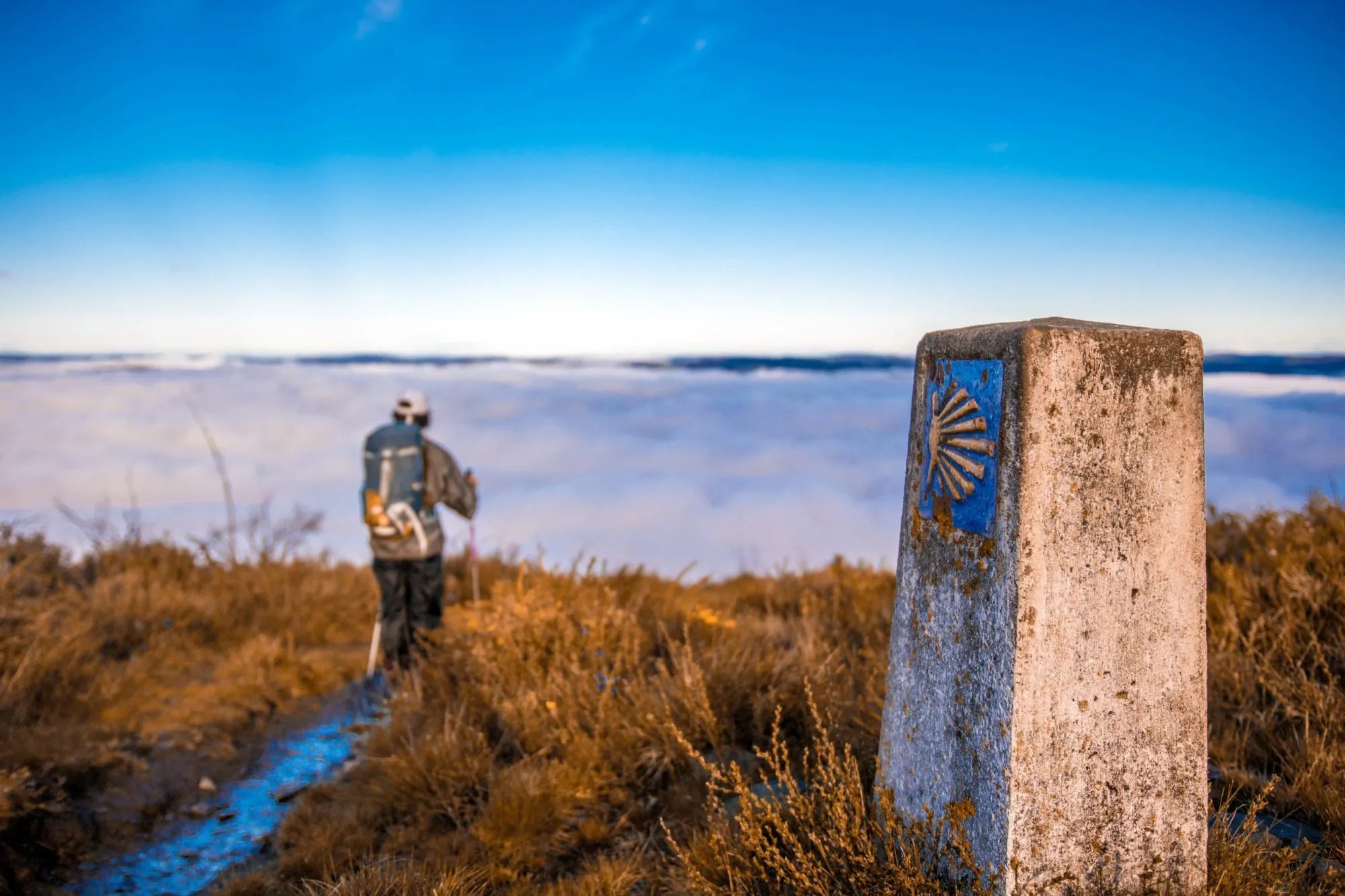Camino Primitivo: The Ultimate Guide
Explore the Camino Primitivo guide for an insightful journey through its history, terrain, and how to embark from Oviedo on this ancient pilgrimage.

Quick links
The Camino Primitivo, known as the Original Way, is a remarkable journey through the heart of Spain's rich history and stunning landscapes. This route from Oviedo to Santiago de Compostela is distinguished as the oldest among the Camino de Santiago paths. It takes travelers through the picturesque regions of Asturias and Galicia.

Camino Primitivo in numbers
- Length: Approximately 330 km
- Starting point: Oviedo, Asturias, Spain
- Finishing point: Santiago de Compostela, Spain
- How many days does it take: 12-14 days
- Ideal for: Pilgrims seeking an original and challenging route with a mix of cultural and natural beauty
History and origins
The Camino Primitivo was first traveled by King Alfonso II of Asturias, famously known as Alfonso the Chaste. The king embarked on this pilgrimage from his capital, Oviedo, to the then-known city of Libredon, now Santiago de Compostela, to authenticate the discovery of Saint James' remains.
This journey marked the Camino Primitivo as the earliest route of the Camino de Santiago pilgrimage network.

In those times, the Kingdom of Asturias, with Oviedo at its heart, was a beacon of Christian resistance and identity during the Moorish occupation of most of the Iberian Peninsula. The establishment of the Camino Primitivo not only served a religious purpose but also played a crucial role in preserving the cultural and national identity of the region.
For centuries, until the Kingdom's capital moved to León and the safer French Way became the preferred route for pilgrims traversing the Meseta, the Camino Primitivo was the primary path to Santiago de Compostela.
Despite the emergence of newer routes, the Camino Primitivo has retained its allure, drawing pilgrims who seek a more authentic, rugged, and solitary experience closer to the medieval pilgrimage tradition.
Highlights
Cathedral of San Salvador in Oviedo
This Gothic-style cathedral, also known as Holy Ovetensis, is a pivotal monument on the Camino Primitivo. The construction began in the late 13th century, evolving over three centuries to include a cloister, chapter house, and several chapels. The cathedral stands on the site of a pre-Romanesque cathedral complex, retaining some of these ancient elements. Its Holy Chamber, a UNESCO World Heritage Site, houses the crosses of angels and victory, significant symbols of Oviedo and Asturias.

Monastery of San Salvador de Cornellana
Founded in 1024 by Infanta Cristina and her mother, Queen Velasquita, this monastery is a significant historical structure on the route. It includes a basilica-plan church with cruciform pillars. A notable feature is a relief depicting a bear nursing a girl, tied to a legend involving the infanta. Post-Infanta Cristina's demise, the monastery was handed over to the monks of Cluny in 1122.

The Roman Walls of Lugo
Lugo's Roman Walls, built in the late third century AD, are a UNESCO World Heritage Site and the only complete circuit of city walls from the Roman Empire still existing. They represent a significant historical and architectural landmark on the Camino Primitivo.

Monastery of Santa María la Real de Obona
Although its exact founding date is uncertain, this monastery is believed to have been established in 871 by Adelgaster, the son of King Silo. In the 12th and 13th centuries, it emerged as a significant Benedictine center. King Alfonso IX recognized its importance, declaring it a mandatory stop for pilgrims to Santiago. The monastery complex includes a church, convent rooms, a cloister, and a hostelry, with the church being the oldest surviving structure.

Palace of Cienfuegos de Peñalba
Originally a fort near Pola de Allande, this palace has a storied past. It transitioned from the ownership of Los Ponce to the Counts of Luna and then to the Cienfuegos family in 1515. Reconstructed in 1520 on its original 15th-century foundations, the palace underwent several modifications, retaining its Gothic style primarily on the ground floor. The palace is characterized by its L-shape and three distinct towers.

Terrain and difficulty
Starting with the mountainous stretches from Oviedo to Lugo, Camino Primitivo features steep ascents and descents along rugged paths, testing endurance while offering breathtaking views of the Asturias region.
As the journey unfolds, pilgrims traverse serene, lush forests, where shaded and tranquil paths can turn uneven and muddy, especially after rainfall.

The path then meanders into rustic, rural landscapes, showcasing the agricultural heartland of northern Spain with its gentle rolling hills and farmlands. This change in scenery provides a gentler walking experience, though the long stretches can still be physically taxing.
Adding variety to the journey are sections that lead across rivers and through valleys, where the tranquil beauty is interspersed with the need for careful navigation on potentially slippery trails.
Approaching Santiago de Compostela, the Camino Primitivo transitions into urban and suburban areas, offering smoother paths but a shift from natural beauty to more built-up environments.

Overall, Camino Primitivo is considered the most challenging route of the Camino de Santiago network, not just for the varied terrain but also for the long walking days, significant elevation changes, and occasionally demanding weather conditions.
Despite these challenges, the route remains a deeply fulfilling pilgrimage, offering a unique blend of stunning scenery, cultural richness, and personal achievement.
If you’re searching for information on preparation for Camino Primitivo and access to a packing list, visit our comprehensive Camino de Santiago guide.
Infrastructure
The infrastructure on the Camino Primitivo, while well-developed, is less commercialized compared to other popular Camino routes like Camino Portugues, offering pilgrims a more authentic experience.
Accommodation options along the path are diverse, ranging from albergues, which are economical and provide basic amenities, to private hostels, hotels, and guesthouses.

While these accommodations are strategically located throughout the route, they tend to be sparser in the mountainous regions, making advance booking a wise choice, particularly during peak seasons.
As for dining and supplies, the route is peppered with small towns and villages where pilgrims can indulge in local cuisine and replenish their provisions.
Restaurants, cafes, and grocery stores are readily available, although their frequency diminishes in remote areas, such as the mountainous and forested sections. In these parts, carrying additional food and water is essential to ensure sustenance.
If you wish to read about accommodations and food on Camino de Santiago in more detail, you can visit our comprehensive Camino de Santiago guide.

Regarding medical facilities, larger towns along the Camino Primitivo provide access to healthcare services. Moreover, many albergues and local inhabitants are equipped to handle common pilgrim-related health issues and can offer basic assistance or directions to the nearest medical center.
The Camino Primitivo also benefits from good transportation links and connectivity. Public transport, including buses and taxis, is available, particularly at the start in Oviedo and at the journey's conclusion in Santiago de Compostela.

Trail maintenance and signage on the Camino Primitivo are commendable, with clear markings like the iconic yellow arrows and scallop shell symbols guiding the way.
The paths are generally well-kept, although their condition can vary with changing weather, especially in mountainous areas.
In summary, the infrastructure along the Camino Primitivo adequately supports a comfortable and safe pilgrimage. While it might offer fewer amenities compared to busier routes, its simplicity and authenticity significantly enhance the overall pilgrimage experience.
How to get to the starting point?
The Camino Primitivo begins in Oviedo, the capital city of the Asturias region in northern Spain. Reaching Oviedo, the starting point of this historic route, is fairly straightforward, whether you're coming from within Spain or abroad.

By Air
For international travelers, the nearest major airport is Asturias Airport (OVD), located about 47 kilometers from Oviedo. The airport serves several European cities with direct flights and has connections to major international hubs. From the airport, you can take a bus or taxi to Oviedo, with the journey taking around 40-50 minutes.
By Train
Oviedo is well-connected to the Spanish railway network, Renfe. There are regular train services from major Spanish cities like Madrid and Barcelona. The train journey offers a scenic route, allowing you to witness the beautiful landscapes of Spain en route to Oviedo.
By Bus
The bus network in Spain is extensive and offers a more economical way to reach Oviedo. Buses from different parts of the country, including direct routes from cities like Madrid, Barcelona, and Bilbao, are available. The bus journey, while longer than the train, is comfortable and cost-effective.
By Car
For those who prefer to drive, Oviedo is accessible via a well-maintained network of highways. Driving to Oviedo can be a great option if you want the flexibility to explore the region at your own pace before starting the Camino.

Local Transportation in Oviedo
Once in Oviedo, the city's compact size makes it easy to navigate. Public buses, taxis, and walking are all viable options for getting around the city and reaching the Cathedral of San Salvador, the official starting point of the Camino Primitivo.
It's advisable to plan your journey to Oviedo in advance, considering factors like time, budget, and personal preferences.
Now you know how to go, but do you also want to know when? We’ve explored the best time to visit the Camino de Santiago in more detail in our comprehensive Camino de Santiago guide.
Our Camino Primitivo tours
For those seeking a more structured and hassle-free Camino Primitivo experience, traveling with a hiking agency can be an excellent option. Agencies offer a range of services, including pre-arranged accommodations, luggage transfers, and detailed route guides.
You can explore our Camino Primitivo tours to find a package that suits your needs. Our services are designed to enhance your pilgrimage, ensuring a memorable and fulfilling journey on the Camino Primitivo.

HASSLE-FREE
We handle itineraries, accommodations, and anything else you prefer not to deal with, so you can enjoy a carefree hike.
.svg)
TRIED & TESTED ADVENTURES
Only the best of Camino de Santiago, cherry-picked by our local team with an in-depth knowledge of the region.

SELF-GUIDED TRAVEL
Explore independently and with confidence while we keep everything running from behind the scenes.
TRUSTED BY MANY
Since 2014, we have taken care of thousands of happy customers, making it our mission to put your satisfaction first.

